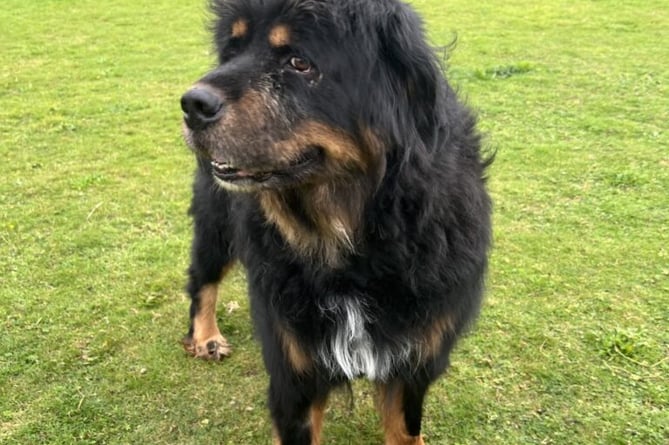Meet Leo – a seven-year-old Tibetan mastiff who is looking for his new family, having been a much-loved pet with his previous owners.
They were unable to keep him due to a change in their circumstances, and not because he did anything wrong.
Leo’s ancestry is an interesting one. The Tibetan mastiff is regarded by many as one of the world’s most ancient breeds, dating back over 3,000 years, as well as the ancestor of all the mastiff breeds.
They were originally bred in the Himalayan region to protect livestock and property, and they were often tethered near the entrances to farmsteads and monasteries to deter intruders.
Early British explorers wrote about a giant breed of dog, with its thick coat enabling it to withstand extreme cold.
Marco Polo reported that the Tibetan mastiff was ‘as tall as a donkey with a voice as powerful as that of a lion’.
The Tibetan mastiff was considered to be such an exotic dog that in 1828 George IV presented one to London Zoo; and then the Viceroy of India sent one to Queen Victoria in 1847.
Other historical records show that the Dalai Lama had eight Tibetan mastiffs guarding his summer residence at Norblinka – two at each entrance. But then the Chinese invasion of Tibet in 1950 led to the compulsory slaughtering of most dogs, and only a few Tibetan mastiffs living in remote areas escaped with their lives.
It was this stock that formed the foundation for the modern breed, which has only become more commonplace in the last few decades.
In the 1970s, the breed became infamous for being part of a Nepalese drug smuggling operation, which shipped illegal narcotics into the USA.
The drugs were stored in the bottom of the dogs’ crates, and unsurprisingly the customs officials were not particularly keen to search them.
Leo is a perfect example of a Tibetan mastiff and shows many of the breed’s traits: he is loyal and gentle and thoroughly enjoys the company of people; he has a calm and serene nature, and a ‘serious’ demeanor; he enjoys walks and is mannerly on and off the lead, but he’s not overly interested in playing with, or chewing, toys; and he is generally good with other dogs (and tolerates cats).
It goes without saying that Leo’s considerable size means he needs to live in a home where he has plenty of indoor and (secure) outdoor space, and he needs a moderate amount of exercise every day – ideally walks in the countryside with lots of opportunity to sniff and explore.
One of Leo’s most unusual qualities is his coat. You might expect it to be quite harsh to the touch, given it was designed to withstand cold weather, but it is, in fact, incredibly soft and luscious.
The lion-like mane of extra thick fur around his head and shoulders makes him, quite possibly, the most cuddly dog we have had in our kennels for some time.
Tibetan mastiffs ‘blow’ their coat once a year, rather than continuously shedding it, and so they don’t leave long hairs on floors and furniture all year round. Leo will need regular grooming, though, to keep his coat in such good condition.
Although Leo is well socialised with other dogs and children, he would be best suited as the only dog in a household where he can form a strong bond with his new owner(s) without any competition.
His size and strength mean that he could unintentionally harm a child, and so an adult-only household would be best for him.
The expected lifespan of a Tibetan mastiff is between 12 and 15 years, and so Leo has plenty of time left to be a devoted and enjoyable companion with his new owner(s).
However, he isn’t the dog for first-time dog owners, and ideally he needs to be with people who have experience with large breeds.




